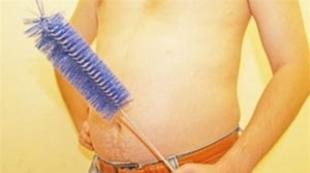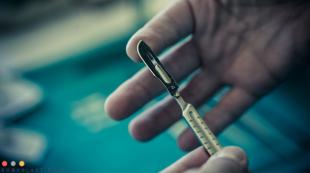Marine knots knitting scheme. How to learn how to knit a marine knot? Types and their knitting method

Bowline . (photo: brig-club.ru)
People not familiar with nautical terminology may think that the name "arbor knot" comes from the verb "to chat" or from the noun "arbor". In the maritime language, the name of this node comes from the "gazebo", but not from the usual, but from the marine arbor, which is a small wooden board - a platform that serves to lift a person onto the mast or lower the ship overboard during painting or other work. This board with the help of cables is attached to the lifting cable with a special knot, which is called the gazebo knot. Its second name is bowline. It comes from the English term "bowline", denoting tackle, which is used to pull the windward leech of the lower straight sail. This tackle is knitted to the leech of the sail with a bowline knot, or simply a bowline.
This is one of the oldest and most amazing knots ever invented by man. Archaeologists testify that the gazebo was known to the ancient Egyptians and Phoenicians for 3000 years BC. The arbor knot, despite its amazing compactness, simultaneously contains elements of a simple knot, half-bayonet, weaving and straight knots. The elements of all these nodes in a certain combination give the gazebo node the right to be called universal. It is surprisingly easy to knit, even with strong traction it never tightens "tightly", does not spoil the cable, never slides along the cable, does not untie itself and is easily untied when necessary. The main purpose of the gazebo is to tie a person with a cable under the armpits as a means of insurance when climbing to a height, lowering overboard or in a smoky room during a fire on board a ship. You can insert a gazebo into the non-tightening loop of this knot.
 The easiest knitting method. Always in life. the ability to quickly tie a bow knot around your waist can come in handy. You need to be able to do this with one hand with one continuous movement of the brush, in the dark, in 2 - 3 seconds. It's not hard to learn this at all.
The easiest knitting method. Always in life. the ability to quickly tie a bow knot around your waist can come in handy. You need to be able to do this with one hand with one continuous movement of the brush, in the dark, in 2 - 3 seconds. It's not hard to learn this at all.
Take the root end of the cable in your left hand, with your right hand encircle the running end behind you around your waist. Take the running end in your right hand and, stepping back about 10 centimeters from its end, hold it in your fist. Take the root end in the left hand and stretch the left hand forward. Now, having the root end of the cable slightly taut, with the right brush with the running end clamped in it, go around the root end of the cable from top to bottom towards you and up away from you. Try to make such a movement with the brush so that it does not completely fall into the loop. Next, wrap the running end around the stretched root end to the left, intercept it with the thumb and forefinger of the right hand. Pulling the right hand out of the loop, simultaneously push the running end into the small loop. Holding the running end with the right hand, pull the root end with the tape. After doing this several times in a row, you will learn how to tie a bow knot on yourself, in the dark or with your eyes closed. Imagine the following situation: you find yourself over the side of the ship in the water, they throw you a line from the deck, along which you cannot climb up, because it is slippery. By tying a harness knot around your waist and moving the resulting armpit loop, you can ensure that you are safely pulled out of the water onto the deck. This magnificent knot has saved the lives of sailors more than once. To untie the gazebo knot, it is enough to slightly move the loop of the running end along the weakened root of the cable.
 (photo: kakimenno.ru)
(photo: kakimenno.ru)
Works just like a regular bowline. It is used in cases where it is necessary to tie two loops at one end at once. For example, lifting an injured person. Then the victim's legs are threaded into loops, and a half-bayonet is knitted around the chest under the armpits with the root end. then the person will not fall out anywhere, even if he is unconscious.
Knot "eight".

"Eight" . (photo: brig-club.ru)
This knot is considered a classic. It forms the basis of a dozen other, more complex nodes for various purposes. In the form in which it is shown here, this knot in maritime affairs serves as an excellent stopper at the end of the cable so that the latter does not splash out of the block pulley. Unlike a simple knot, even with strong traction, it does not spoil the cable and can always be easily untied. To tie the figure eight, it is necessary to encircle the running end of the cable around the main one and then pass it into the loop formed, but not immediately, as in a simple knot, but first winding it for yourself. This knot can be applied to the rope handles of a wooden pail or bucket if the rope passes through the two holes on the protruding ends of the wooden staves. In this case, after threading the rope through both holes, at its ends, on the outer sides, the rivets are tied in a figure-eight. With two figure eights, you can securely attach the rope to the children's sled. To prevent the hand from slipping off the end of the dog leash, we advise you to tie a figure eight. In addition, it serves well for attaching strings to the tuning pegs of violins, guitars, mandolins, balalaikas and other musical instruments.

The figure-eight knot is very easy to knit and can be done with just one hand.
- Perform the first stick.
- Then pass the running end under the root.
- Pass it through the first peg and tighten the knot.
Dagger Knot. Knot for tying two cables or ropes.

It is considered one of the best knots for tying two large diameter cables. It is not very complicated in its scheme and is quite compact when tightened. It is most convenient to tie it if you first lay the running end of the cable in the form of a figure of the number 8 on top of the main one. After that, thread the elongated running end of the second cable into loops, pass it under the middle intersection of the figure-eight and bring it out over the second intersection of the first cable. Next, the running end of the second cable must be passed under the root end of the first cable and inserted into the figure-eight loop, as the arrow indicates. When the knot is tightened, the two running ends of both cables stick out in different directions. The dagger knot is easy to untie if one of the extreme loops is loosened.
(photo: poxod.ru)
 Archaeological finds indicate that the Egyptians used it about three thousand years before our era. The ancient Greeks and Romans called it Nodus Hercules - the Hercules or Hercules knot, because the mythical hero Hercules tied the front paws of the skin of the lion he had killed on his chest with it. The Romans used the straight knot to stitch wounds and heal broken bones. It consists of two half-knots, sequentially tied one on top of the other in different directions. This is the usual easiest way to knit it. Sailors, who have been using this knot since ancient times to tie cables, use a different knitting method. Weavers who use a straight knot to bind broken threads of yarn tie it in their own way, in a special, convenient way for them.
Archaeological finds indicate that the Egyptians used it about three thousand years before our era. The ancient Greeks and Romans called it Nodus Hercules - the Hercules or Hercules knot, because the mythical hero Hercules tied the front paws of the skin of the lion he had killed on his chest with it. The Romans used the straight knot to stitch wounds and heal broken bones. It consists of two half-knots, sequentially tied one on top of the other in different directions. This is the usual easiest way to knit it. Sailors, who have been using this knot since ancient times to tie cables, use a different knitting method. Weavers who use a straight knot to bind broken threads of yarn tie it in their own way, in a special, convenient way for them.
With heavy loads on the tied cables, as well as when the cables get wet, the straight knot is strongly tightened. How can a straight (reef) knot be untied, which is so tightened that it cannot be untied and will have to be cut. A straight knot, even wet and tightly tightened, is untied very simply, in 1 - 2 seconds.


Take ends A and B in your left hand, and ends C and D in your right hand. Pull them strongly in different directions and tighten the knot as tight as possible. After that, take the root end A in your left hand (so that it does not slip out of the hand, make a couple of hoses around the palm). Take the running end B in your right hand (you can also wrap it around your palm.). Pull the ends sharply and strongly in different directions. Without releasing end A from your left hand, hold the rest of the knot in your fist with your right hand, holding it with your thumb and forefinger. Pull root end A to the left side - the knot is untied. The whole secret lies in the fact that when the ends of A and B are jerked in different directions, the straight knot turns into two half-bayonets and completely loses all its properties. It is also easily untied if you take the root end D in your right hand and pull the running end B strongly to the left. Only in this case, the end of G must then be pulled to the right, and the rest of the knot (half bayonets) to the left. When untying a straight knot in this way, remember that if you pulled the running end to the right, pull the root to the left and vice versa. When untying a straight knot, one should not forget that with what force it was tightened, it is necessary to pull one of its running ends with the same force.
Fishing bayonet, anchor knot.
 A very reliable node.
A very reliable node.  One of the most critical cases of using a knot in maritime business is tying an anchor rope to an anchor. For five thousand years of the existence of shipping, people for this purpose could not come up with a more reliable knot than this one. Proven by centuries of experience in maritime practice, this knot is recognized by sailors of all countries as the most reliable for attaching a rope to an eye or to an anchor bracket. The fishing bayonet (or anchor knot) is somewhat similar to a simple bayonet with a hose. It differs from it in that the first of the two half-bayonets passes additionally inside the hose that wraps around the object. When using this knot for anchoring, it is always necessary to grab the running end with a scrum to the root. In this case, even with a very strong pull, the fishing bayonet does not tighten and holds securely. It is fashionable to safely use it in all cases when working with cables, when they are subject to strong traction.
One of the most critical cases of using a knot in maritime business is tying an anchor rope to an anchor. For five thousand years of the existence of shipping, people for this purpose could not come up with a more reliable knot than this one. Proven by centuries of experience in maritime practice, this knot is recognized by sailors of all countries as the most reliable for attaching a rope to an eye or to an anchor bracket. The fishing bayonet (or anchor knot) is somewhat similar to a simple bayonet with a hose. It differs from it in that the first of the two half-bayonets passes additionally inside the hose that wraps around the object. When using this knot for anchoring, it is always necessary to grab the running end with a scrum to the root. In this case, even with a very strong pull, the fishing bayonet does not tighten and holds securely. It is fashionable to safely use it in all cases when working with cables, when they are subject to strong traction.

This knot is also called the scaffold or "hanging" knot. But despite this, it also finds other uses in maritime affairs. It is used for temporary fastening of a cable for objects floating in the water or for throwing and fastening a cable for any object on the shore. This knot has an advantage even over such a good knot as a half-bayonet garrote, in that the running end of the cable cannot slip out of the loop, and therefore a tightening garrote is considered more reliable. On sailboats, this knot was used to fasten the root ends of the mars-sheets and mars-git and other gear in cases where it was necessary to have these ends ready for recoil. To tie this knot, the cable is laid in the form of two loops of the same size. Both loops are surrounded several times with the running end of the cable, after which this end is passed into the loop facing the root of the cable, and, pulling out the extreme loop, they are clamped in it. A tightening noose can always be easily untied by pulling on the root of the cable. This gloomy knot can be used well in maritime affairs in two ways. Firstly, according to the scheme of its knitting, it is convenient to store the cable in the form of a compact bay. By making this knot without a loop at the running end of the throwing end, you will get excellent heaviness. If you find it not heavy enough, dip it in water before use.
 It has long been considered one of the most reliable knots for tying cables of different thicknesses. They even tied anchor hemp ropes and mooring lines. Having eight weaves, the flat knot never tightens too much, does not creep and does not spoil the cable, since it does not have sharp bends, and the load on the cables is evenly distributed over the knot. After removing the load on the cable, this knot is easy to untie. The principle of a flat knot lies in its shape: it is really flat, and this makes it possible to choose the cables connected by it on the drums of capstans and windlasses, on the welps of which its shape does not interfere with the even overlap of subsequent hoses.
It has long been considered one of the most reliable knots for tying cables of different thicknesses. They even tied anchor hemp ropes and mooring lines. Having eight weaves, the flat knot never tightens too much, does not creep and does not spoil the cable, since it does not have sharp bends, and the load on the cables is evenly distributed over the knot. After removing the load on the cable, this knot is easy to untie. The principle of a flat knot lies in its shape: it is really flat, and this makes it possible to choose the cables connected by it on the drums of capstans and windlasses, on the welps of which its shape does not interfere with the even overlap of subsequent hoses.
In marine practice, there are two options for knitting this knot: a loose knot with tacking of its free running ends to the root or half-bayonets at their ends and without such a tack when the knot is tightened.  A flat knot tied in the first way (in this form it is called a Josephine knot) on two cables of different thicknesses almost does not change its shape even with very high traction and is easily untied when the load is removed. The second knitting method is used for tying thinner than anchor ropes and mooring lines, cables, with the same or almost the same thickness. At the same time, it is recommended to first tighten the tied flat knot with your hands so that it does not twist with a sharp pull. After that, when a load is given to the connected cable, the knot crawls and twists for some time, but, having stopped, it holds firmly. It is untied without much effort by shifting the loops covering the root ends. As already mentioned, a flat knot has eight intersections of cables and, it would seem that it can be tied in different ways, there are 256 different options for tying it. But practice shows that not every knot from this number, tied according to the principle of a flat knot (alternating intersection of opposite ends from under and over), will hold securely. Ninety percent of them are unreliable, and some are even dangerous for tying cables designed for strong traction. Its principle depends on changing the sequence of intersection of the connected cables in a flat knot, and it is enough to slightly change this order, as the knot receives other negative qualities. Before putting this knot into practice for any important business, you must first remember exactly its scheme and tie the cables exactly along it without any, even the most insignificant deviations. Only in this case, the flat knot will serve you faithfully and will not let you down.
A flat knot tied in the first way (in this form it is called a Josephine knot) on two cables of different thicknesses almost does not change its shape even with very high traction and is easily untied when the load is removed. The second knitting method is used for tying thinner than anchor ropes and mooring lines, cables, with the same or almost the same thickness. At the same time, it is recommended to first tighten the tied flat knot with your hands so that it does not twist with a sharp pull. After that, when a load is given to the connected cable, the knot crawls and twists for some time, but, having stopped, it holds firmly. It is untied without much effort by shifting the loops covering the root ends. As already mentioned, a flat knot has eight intersections of cables and, it would seem that it can be tied in different ways, there are 256 different options for tying it. But practice shows that not every knot from this number, tied according to the principle of a flat knot (alternating intersection of opposite ends from under and over), will hold securely. Ninety percent of them are unreliable, and some are even dangerous for tying cables designed for strong traction. Its principle depends on changing the sequence of intersection of the connected cables in a flat knot, and it is enough to slightly change this order, as the knot receives other negative qualities. Before putting this knot into practice for any important business, you must first remember exactly its scheme and tie the cables exactly along it without any, even the most insignificant deviations. Only in this case, the flat knot will serve you faithfully and will not let you down.
To properly tie a marine knot, first of all, you need to remember that the fixed end of the rope is called the root, and the movable end is called the running one. There are several simple examples of knitting that will come in handy both at home and during outdoor activities.
It is also called gazebo and belongs to the fundamental knots. It contains elements of several schemes, which gives it universal properties: the mount allows mooring, securing sailors, fixing the rope to the hook. Bowline is very reliable, it can be used with almost all ropes, regardless of material and thickness. The arbor is quickly tied and easily untied (but not spontaneously), it does not slip, and when used in marine conditions, it shows high reliability.
Knitting pattern for a sea knot for beginners:
- Form a loop from top to bottom.
- Pass through it the running end from the bottom up.
- Spend the running behind the root and again skip into the loop.
- When the running end is enclosed in the resulting small loop, the rope must be tightly tightened.
To untie the bowline, it is enough to slightly shift the loop in the direction from the running to the root end.
Knitting a marine knot figure eight
This is a typical modification, which got its name due to its characteristic shape. The figure eight is usually performed to form a stopper or stable attachment. The main plus is that it is easy to deal with, even if the rope gets wet.

How to knit a marine knot:
- Circle the running end of the root, pull the first one from above so that you get a loop.
- Pierce the resulting loop with the running end so that it can then be brought in for itself.
- Tighten.
A beautiful knot is formed with rounded outlines of the figure eight.
Knitting pattern for a straight sea knot
One of the oldest modifications, in ancient Greece, the knot was called Hercules. With it, you can firmly connect two ropes that have approximately the same diameter. But the scheme cannot be called reliable: under heavy loads, the junction will stretch excessively, often it slides along the cable. It is not recommended for use in critical situations and when activities involving immersion in water are planned.

Classic technique:
- Take 2 running ends of the cables, one should cover the second.
- The other end forms an open loop.
- It is necessary to stretch the rope into this loop so that the first end is also braided.
- Tighten both ropes.
There is a subspecies of the direct knot - reef, it is distinguished by the ability to quickly untie.
Half bayonet and bayonet
The half-bayonet is not tightened, to perform it, the object on which it is planned to fix the cable is wrapped with the running end, circled around the root and passed through the formed loop. Then both ends are fastened together. The unit is able to withstand a lot of weight, is reliable.

With the help of a bayonet, the mooring ends are fixed and towing is performed. It is based on 3 half-bayonets - this amount is enough for any purpose. It cannot be considered that 4 or 5 half-bayonets are stronger, the effect when used will be the same.
How to tie a sea knot with a fishing bayonet

This variation has ancient roots, it has survived to this day due to the fact that it allows you to fix the rope at anchor as tightly as possible, it is adapted for all types of manipulations in conditions of strong traction. Initially, you need to fix the cable on the object with the help of an additional hose, then you can begin to form half-bayonets. The first of them must capture the hose encircling the base.

If the ends of the rope are not visible, outwardly this knot cannot be distinguished from a straight one. It got its name due to the fact that this similarity was actively used on ships in order to identify the fact of theft of personal property of sailors, provisions. The connection is used mainly for domestic purposes, since when tensioned, the knot can spontaneously untie.
Procedure:
- The running end of the first rope is folded into a loop.
- The second cable is threaded into this loop in such a way as to capture the root and running ends, and lead out in the opposite direction.
- Tighten both double ends.
Indicative cords are often attached in this way.
How to tie a woman's and mother-in-law's sea knot: a simple diagram
The variations are extremely similar: these are two erroneous ways of forming a thieves knot. The names “baby” and “mother-in-law” are based on the specifics of everyday use - they are widely used to connect ropes, but they do not take into account the unreliability and even some danger of sliding fastening.

Knitting a sea knot is not difficult: two running ends pass through each other in different directions and duplicate this action in a mirror image.
Professional sailors and adherents of an active lifestyle demonstrate the woman's knot only for educational purposes, since its use in the field is fraught with injury and property damage.
The mother-in-law's knot differs from the woman's knot in that here the ends of the cable come from the finished combination in a diagonal direction. The modification was first used in European countries in shipping, but subsequently it was replaced by more practical and stronger knitting options that do not have the ability to spontaneously untie. Now, in practice, it can only be found in the subsidiary farm as an auxiliary link for packaging raw materials and food products.
To perform the mother-in-law knot, you should:
- Form an incomplete loop from the running end of one rope.
- Draw the second end into the loop from top to bottom, go around the first rope and bring it out.
Even if tightened tightly, there is a high probability that with further tension the ligament will open.
Types and methods of performing a noose knot
The noose knot can be performed in straight, flat, fishing variations. In the first case, a strong bond is formed, which increases the strength when wet.

Knitting pattern:
- Form an open loop on the rope: give it the shape of the letter "s" and proceed to the formation of turns, located as close as possible in relation to each other.
- Thread the running end into the lower eye left after winding the rope.
- Tighten.
The carabiner choke has a narrow scope - it is popular with professional climbers. Here, the running end is fixed on the carabiner with an 8-shaped connection, the remaining part of the rope, if necessary, can be passed through the carabiner with coverage of the support, say, a tree.
The noose on the support is knitted as follows: the rope covers the support, enters the loop and wraps around it 3 times, then passes into the small loop. Even if the rope is wet, a stable connection is formed that can be used without support.
All marine knots, despite the characteristic name of the category, are widely used in everyday life. Thieves, mother-in-law and women - a quick opportunity to pull the neck of the bag, a noose with a skillful approach helps in working with loads and sports. All variations of bayonets allow you to quickly fix the rope on a stationary support. It must be remembered that the strength of the connection depends not only on the skill of tying, but also on the strength of the rope.
The art of tying sea knots is actually useful not only for those who regularly sail on ships. It will be useful for any tourist to have a couple of such tricks in their arsenal, but at least for a more durable installation of a camping tent and fitting a rain tent to it. And how interesting this process is in itself! For those who wish to learn how to tie sea knots, schemes and methods are given in this article.
in our life
Knitting knots is one of the first things mankind learned in the course of its evolution. They fastened tools, made the first snares and traps for hunting, as well as locks.
The very first ropes were strips of tree bark, vines, animal skins. They fastened the first clothes and the first bed. Gradually, people mastered weaving and were already able to make ropes on their own, making them stronger and longer. Yes, and it was thanks to them that for the first time its main symbol, the flag, rose above the state.
The rope is a faithful companion of a person in travel, both sea and air. It is difficult to imagine using a rope without knitting knots. These words have long been associated with each other. It was the sailors who were the first to start knitting sea knots, the patterns of which can be found in textbooks on rigging.
Marine knots: history and knitting pattern
They are an integral part of human culture, it is difficult to imagine our world without them. New nodes continue to be invented today, and each of them receives authorship, like an invention, and a patent.
Their genius lies in their simplicity. They can be locking, quick-release, tightening and non-tightening. This art has been passed down from generation to generation. Thanks to the ropes, the first devices for swimming on water appeared - rafts. The knot also has a mystical meaning - it is not just a way of fastening, but a talisman that protects its owner from trouble.
The sailors of Northern Europe had a belief about three magic knots - correctly tied to ship gear, they kept them from crashing. There was even a ritual for untying, which was supposed to cause the wind.
In the heyday of navigation, there were about 500 knots. Their names are derived from the gear to which they were applied - for example, pile or boat. Nowadays, knots are also identified with the country where it was invented - the Spanish bow knot or the Flemish loop.
The working ends of the cable, with which knitting is carried out, are called running. They circle around the indigenous ones, which remain motionless. These ends are opposite to each other.
To this day, you can find peoples who have not been touched by the blessings of civilization, and they still make weapons and snares for hunting and fishing using knots.
Rope knots: their types and methods of knitting
You will need a rope that is not very thick and soft enough. Just like in knitting, training is needed here. From the first time you will remember little, so each new node must be worked out several times. And of course, they need to be used in everyday life, otherwise they will quickly be erased from memory.
Yes, each of them has its own name. But do not focus too much on them, it is better to memorize the sequence of combinations. There are not many established names, and more often they depend on the source.
The simplest knot is knitted like this: a loop is made at one end of the rope, into which the running end is threaded. All. Its disadvantage is a decrease in the strength of the rope. An experienced angler or navigator always trims randomly tied simple knots or replaces them.
You can start working on knitting skills with the "eight". It does not reduce strength and is easily untied. The practical value is to limit the movements of the rope. The figure eight is an element of other more complex knots.

If you need to join two ropes, tie a straight (or reef) knot. To increase reliability and strength at the running ends, you need to make figure eights. When knitting, two ropes are crossed twice in succession. One of the free ends is folded in half, forming a bow. If the number of running revolutions is made more, it will turn out which is knitted on stretched cables.
Extra yarns and turns can not only ruin everything, but also make a completely different knot out of one. Therefore, when knitting, carefully follow the directions of the coil.
Classification
Direct or reef is included in the 24 main sea knots. Why are they called that? It is believed that they are the most common in navigation, and it was with them that everything began. In this classification, straight and reef knots are two knots, although the principle of their knitting is absolutely the same. Figure eight and surgical (or double straight) are also included here.
In cases where it is necessary to tie the ends of two ropes, a flat knot or bayonet is knitted. Its distinguishing feature is symmetry. Knitting technology: one of the ends is folded in a loop, the other end is wrapped around in the same way, the ends stretched through are pulled together. They must be intertwined one through the other.
One of the most used in rigging is the pile knot. The running end is inserted into the loop with the same loop. Tighten it around an object, otherwise it will not tighten.
Separately, such knots of the "bayonet" type are distinguished. This is a straight line, with two hoses, with a run-out and a fishing one. The first is used for high-quality mooring. The technology of its knitting has already been described above. Here everything is the same, only the rope first wraps around the mooring fell. To reduce cable wear, a bayonet with two hoses was invented. At the same time, the rope wraps around the fell twice. The bayonet with a run-out has an additional loop. This is done for even greater reliability. Rybatsky differs from a knot with two hoses in that an additional loop is knitted, and not just thrown over. It is used for anchoring.
To tightly tie the cable on something, another rope or rope, they knit the running end, which is carried around the object, carried over the root. The second hose is knitted in the opposite direction.

There are also knots called retractable bayonet, buoy knot, double arbor and simple arbor, noose, top, double eight, locking, towing and boat. There is one called It does not tighten at all and is used to secure the lines. Outwardly, it looks like an intricate weave.
The most famous
The main quality of marine knots is reliability, as well as simplicity and the ability to do it with just one hand. Simplicity seems out of place here, but in fact, intricate sea knots are knitted really quickly and easily thanks to a well-tuned technology.
The 15 popular maritime knots include the familiar figure-of-eight, straight and flat, twin-hose bayonet, fishing bayonet, stop and reef knots, as well as the garrote, tightening garrote, Portuguese bowline, improved dagger knot, Flemish noose and Flemish knot.
Why are they included in this classification? They are widely used not only in maritime affairs, now they are indispensable, for example, for climbers. Imagine that you urgently need to throw a lasso with a reliable knot on a rock or quickly wrap a rope around your waist with one hand so that you are pulled out of a place that is difficult for other people to reach.
Enough theory
Now you know what exactly sea knots are. Drawings, knitting patterns for some of them, namely those that can be applied in everyday life, are listed below.
For training, use a regular clothesline and a chair. First, just do the simplest ones. To do this, you need to throw the rope over the crossbar and carry one end through the resulting loop.
And here is how the Flemish knot is knitted, one of the simplest and most popular. It will come in handy for you to securely fasten two ropes together.

At the end of one rope, make a loose figure eight, and now take the running end and carry it, as if imposing, over the root. Now you need to stretch it through the leftmost ring. If you are interested in how other sea knots fit, you can find two more schemes in this article.
We knit a double gazebo knot
This skill can be very useful to you in life, because it is used to create a reliable foothold, in the construction of hanging arbors or scaffolds, and it is also useful for creating an emergency lifting mechanism. The picture shows, the circuit is painted below.

Make an open loop in the middle of the rope. Now you need to fold it closed and thread the end of the first through it. Circle the elongated loop around the entire knot to the very root ends. Tighten.
Let's try to tie a Portuguese bowline
If suddenly a difficult situation occurs in your life when you have to lift a wounded person, this knot can be very useful. Its purpose is to create two loops in which you can just put your feet. The root end is then knitted with a half bayonet under the armpits, so that the fastening is as reliable as possible for an unconscious person.

Make two circular turns on both sides.
Pass the running ends around them. Make a simple knot and pull it to the side. Remember that it does not tighten much. Drag the center coil through the body of the knot.

So you learned how to knit some sea knots. Schemes and drawings of all cannot be reflected within the framework of one article, therefore, for those who are very interested, it is recommended to study specialized reviews or textbooks.
Every day, each of us is faced with such a concept as a knot. The process of tying a man's tie or women's scarf, sports laces is associated with this word. In everyday life, in nature, in the country, as well as during hunting and fishing, this concept is simply irreplaceable.
There are a huge variety of types and forms of how to tie a knot, for example, in nature, connecting logs or when strengthening a tent. All types of knots have their own names and their practical purpose.
In the formation of the navy, the technique of knitting special knots, which received the name - marine knots, acquired importance. In those days, the navy needed strong for work, as well as not difficult to manufacture units, where bulky and unnecessary parts and elements were completely excluded.
Description
 A distinctive feature of marine knots is knitting and techniques for tightening the rope, as a result of which there is an increase in the tension of the cable, which gives reliability to the nodal fastening.
A distinctive feature of marine knots is knitting and techniques for tightening the rope, as a result of which there is an increase in the tension of the cable, which gives reliability to the nodal fastening.
At rest, or rather, when the cable is loosened, the clamp of the sea knot loops is released. With this approach, the knot can be easily untied.
We can safely say that it was the sailors who invented the most ingenious and durable knots. They quite often resorted to the help of ropes, so at the time of the heyday of the sailing fleet, about 500 types of knots could be counted.
Each node name was derived from the name of the gear where they were used. This is clearly seen in the examples - boat, barrel, Turkish knot, as well as a number of other options.
Each knot includes several components, namely the root and running ends, if they are present, a knot, a loop (open or closed type), a run-out or a hose is knitted.
Run-out is the turnover of a particular object with the exclusion of the crossing of the ends. The hose is characterized as a complete girth of the object, including the crossing of opposite ends.
Scope and types
Marine knots are widely used in various fields of activity. They are indispensable for tying boats and light anchors, for lifting loads, for fastening cables, for harnesses and arbors, as well as for lowering various objects from a height, for attaching several poles when building a hut or wigwam.
The specified method of fastening is in demand when traveling, during construction activities, fishing, hiking and in the navy.
As practice shows, the following types of marine knots are often used in fishing:
"Flemish Loop"
With the help of it, the wobbler is attached to the ring on the front of the blade and the leash of the board.
"Deaf, double loop"

This type of knot is designed to fix the wobbler on the monofilament.
Teschin

The knot helps secure carabiners and swivel.
"Fishing Loop"

Formed for a leash when it needs to be connected to the main line. Common name "loop to loop"
To fasten hooks, use the following types of knitting fasteners:
"Palomar"

Its strength is 92%. Suitable for hooks with rings.
"Loop loop"

Strength more than 90%. Used for spatula hooks.
"Mark"

Strength more than 90%.
Marine knots used as a connecting element of the fishing line:
"Eight"

It is a loop with which the wobbler is tied and fastened.
"Double Fisherman"

It is used as a connection for lines of unequal diameter.
Marine knots used for rigging:
"Double Blind Loop"
Sea knots (stop):
"Stop"

The knot is designed for a sliding float.
Rope knots:
"Bowline"

Designed to tie a non-tightening loop. The main application is anchor rope.
"Mooring"

Used when the ship is at the berth.
A variety of sea knots
Straight

Used for fastening and connecting cables of equal diameter. When sufficiently strong loads are applied to the connected cables, this type of knot is able to tighten tightly. To prevent such contraction, a wooden plank is used.
reef

It is necessary when fastening the pins of the covers of ships, as well as when connecting the running ends of the cables.
Eight

Used at the ends of tackle to prevent them from falling out of the blocks.
flat knot

Used when connecting cables different diameter.
simple bayonet

The knot is necessary to secure the mooring cables to the piers.

Used in situations where it is necessary to tie cables, where one of them contains a thimble.
Kalmyk

This type of fastening is widely used when it is necessary to supply the necessary tools., buckets and various items on the mast, overboard, at the time of the necessary work.

This method is used to secure the safety cable, clasping the belt of a person who performs work on the mast or overboard.
How to knit?

- To properly tie a particular knot, you must first learn the main types of common marine knots.
- Familiarize yourself with basic concepts such as running and root ends.
- Learn how to tie a specific knot.
- Constant training. Inexperienced people who rarely tie knots often forget the technique for doing it, so only in practice can you learn how to form a knot.
- Knitting knots is individual in nature, because the same knot can be tied in a variety of ways.
To make a knot correctly, you need to know it and be able to knit it quickly - two main rules. It does not matter how a particular node was formed, the most important thing is the result.
Consider the step-by-step knitting of a stop knot used when fishing with a sliding float:
- We choose a thread, the length of which should be at least 25 cm. It is not recommended to use a fishing line for fishing, an ordinary thick thread is best.
- We fold the thread in half and place it next to the fishing line. The distance doesn't have to be equal. Be sure that the length of one side should not exceed 5 cm.
- Then we wrap the longest end of the thread around the fishing line and the small end.
- We make up to 5 turns, and then thread the long end into the resulting loop.
- .Smoothly, without a sharp stop, tighten the thread and get a knot. Before finally tightening the knot, it is recommended to wet it. Then tighten well. Advice: when creating such a knot, you cannot use a fishing line. This will damage the second line.
- Once you've finished tightening the knot, remove the excess thread, leaving a few inches of extra on each side.
Marine knots are of great practical importance. With their help, it is possible to perform a variety of actions aimed at strengthening structures, it becomes possible to connect and connect several elements, to ensure and guarantee reliability and safety when carrying out various kinds of work.
Nautical knots are a kind of art that dates back to the advent of navigation. And today this art does not lose its relevance. Absolutely every person who decides to make a trip across the open spaces of the sea should have the skills of knitting sea musings. Regardless of what type of sea transport you have, whether it is a yacht or a small boat.
It must be taken into account that your musing must be very durable and reliable, since the safety of your cargo depends on it. And it must be attached exactly so that you can easily untie it at the right time. All beginners need to know a few basics:
- The fixed fastener, which is located at the end of the cable, is called the root.
- The loose end, which begins to move freely when knitting, is called running.

In addition, there is also English terminology:
- KNOT is a musing that secures the running end with the main end.
- BEND is a mousing that attaches a running end with two torsos and connects it into one.
- HITCH is a moussing that attaches the running end to any object.
For beginners, of course, it will be a little difficult, but if you remember the above, then in the future the study of this art will not seem so difficult.

Major maritime knots
There are a decent number of the most important nodes, they should be known to all sailors:
Arbor musing. Eight. Herculean (direct, Turkish) musing.
First things first, you need to remember exactly the gazebo type. It is very versatile, so it is no problem for belaying and mooring. The most reliable way is to link two torsos with this knot. Its merit are:

- Ease of knitting.
- Ease of connection.
- It has absolutely no slip properties.
- High level of reliability.
- Musing figure eight is the most standard maritime knot. It got its name because of the shape, which resembles the number eight. It provides a knitting of several knots.
- Mainly used for fixing.
- It ties very easily
- It just unties.

The oldest of all knots is the straight line. Even in the period of ancient Greece, he was called Herculean. Thanks to him, two torsos having the same diameter are connected. It is often used, but, alas, is not the most reliable. This mousing has an unpleasant property of sliding along the cable.
In addition, it is strongly tightened under significant loads, as well as getting wet. The most important thing is to improve your skills more often, because it is practice that will help you master this art.
How to tie marine moussing?

Below will be listed several ways to knit sea knots. Sea musing how to tie? At first glance, this may seem a little difficult, but if you are attentive and patient, then you will undoubtedly succeed.
Arbor Musing
Make a loop at the bottom and at the top. Pull the running end through it, and then pass it behind the root end and thread it through the loop. The running end must be in another snare. Then it remains only to tighten it as tightly as possible.
Eight

Circle the running end around the root, and then pull it over it. A standard loop should form. It is required to put the running end into it, having previously wound it behind itself. The final action is a strong puff.
direct mousing
Fixing this musing will not be difficult. First you need to hold one running end in one direction, and the second in the opposite direction. Thanks to the numerous diagrams of nautical knots, it is easy to learn. They are quite simple, so it will not be difficult to understand them at all.
There are also other types of nodes that will be useful to you. There are non-tightening and tightening knots. There are also knots for fishing tackle. They can often be found while fishing. Fishermen use them to catch prey. In addition to them, there are knots that serve for decoration. Thanks to such knots, you can easily decorate your home in a real marine style. Such nodes include:

- Royal.
- Three-loop.
- Cord. Turkish (that is, straight knots).
What is sea musing equal to?
The calculation of the distance at sea between the points of the path that sea transport passes, there is a value called the nautical mile. It consists of the average length of the arc and one minute of the earth's meridian.
A knot is a linear speed that consists of one m/h. It is widely used in nautical and aviation practice.
Sea musing in kilometers. According to the standard, one musing is equal to 1.8 kilometers per hour.
Node History

Ancient knots have been discovered in Finland. According to research, it became clear that they belong to the late Stone Age. Of course, the skill of knitting knots came to us much earlier, but material evidence of this, unfortunately, has not survived to our times.
Working with them, a man of that century created various kinds of products that helped him in the household. In addition, they were also used in the creation of various accessories. Also, the knots, according to the people of that time, had magical powers.
As mentioned earlier, direct musing was widely used in ancient Greece. They made a talisman out of it and wore it around their neck, believing that it could protect its owner. In addition, it has also been used in medicine. With it, the Greeks bandaged the wounds of the victims.
They have a large number of interesting legends and stories.

Almost all nodes are not forgotten and have come down to us safe and sound. During the excavations, there were remains of various teams, elements of clothing, accessories, various types of labor weapons, as well as several types of knots. But absolutely everyone was known to this day.
But a big push was given by the development of the sailing fleet. Thanks to him, we were able to create even more nodes that did not have any extra elements. Their history is very rich and from it we can learn how our ancestors lived. What heights they have reached in such art.









